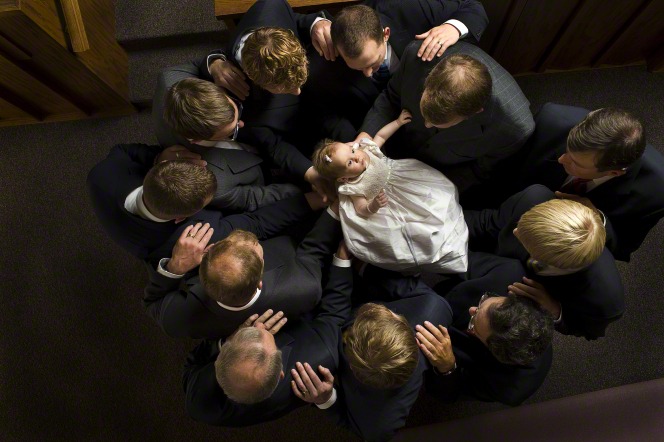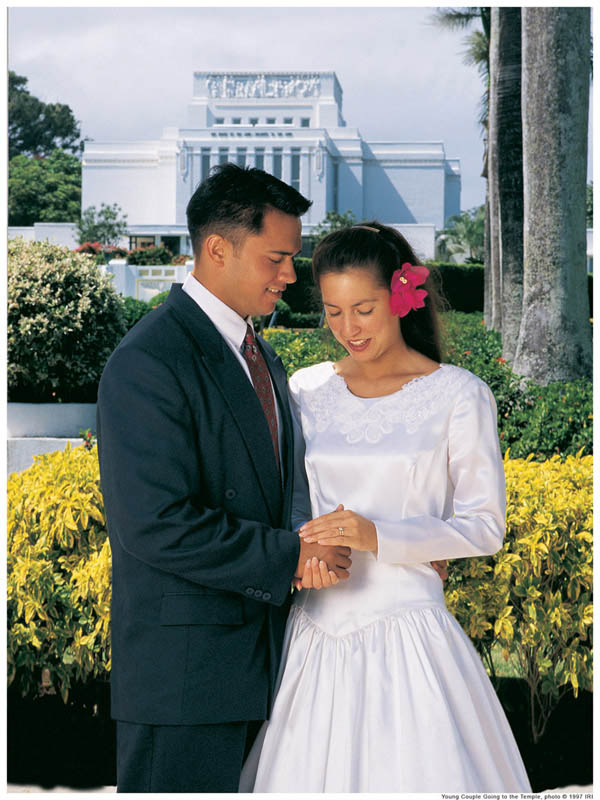Mormon Special Occasions
Special occasions in The Church of Jesus Christ of Latter-day Saints—sometimes inadvertently called the Mormon Church—usually center around sacred ordinances. Ordinances are sacred, formal acts that have spiritual meaning and are performed by the authority of the priesthood (which is the power that God gives to man to act in all things for the salvation of His children). Some ordinances are saving ordinances, meaning that they are essential for our exaltation, or our ability to return to live with God again. Others are not essential for our exaltation but are important for our comfort, guidance and encouragement. The special occasions include baby blessings (akin to christenings or the Jewish ‘’brit’’, without the baptism or circumcision), baptisms (when children turn 8), priesthood ordinations (beginning when a boy turns 12 and receives the priesthood) and marriage in the temple. In The Church of Jesus Christ, families (including extended families), friends and congregations (called wards) often celebrate these events together. Families also gather when missionaries depart and when they return.
Since special occasions in The Church of Jesus Christ focus on sacred ordinances, they are not usually celebrated with large, extravagant parties. More often, they are celebrated with quiet gatherings of family and friends at home after the sacred ceremonies at church.
Blessing of Babies
The blessing of infants is a sacred, but not saving, ordinance in The Church of Jesus Christ. Babies are often dressed in white clothes as a symbol of purity before God. Babies are blessed during sacrament meeting (the main worship service in The Church of Jesus Christ where members partake of the sacrament) on Fast Sunday (a day set aside each month where members abstain from food and water for two consecutive meals, donating what would have been spent on food to help those in need). A baby blessing can also be performed in a private home, if the bishop (congregational leader) is present. A worthy Melchizedek priesthood holder, usually the father, holds the baby and stands in a circle with other priesthood holders, each standing with one hand under the baby and the other on the shoulder of the man beside him. Then the designated priesthood holder gives the baby a name and a blessing in the name of the Lord, offering words of guidance and direction for the child as he or she grows. Priesthood holders follow the guidance of the Holy Spirit in pronouncing blessings upon the child.
Elder Dallin H. Oaks, an apostle of the Lord Jesus Christ—explains:
- In modern revelation, parents who are members of the Church are commanded to bring their children “before the church,” where the elders “are to lay their hands upon them in the name of Jesus Christ, and bless them in his name” (Doctrine & Covenants 20:70). This is why parents bring babies to a sacrament meeting, where an elder—usually the father—gives them a name and a blessing.
Sister Elaine S. Dalton, Young Women general president, described the blessing of one of her granddaughters:
- Recently I attended the blessing of our newest granddaughter. It was a holy sight to me as my husband and our sons, along with many other loved ones, encircled this little infant. She was so elegant all dressed in white—and it didn’t hurt a bit that she was named after her two grandmothers! But the thing that touched me most was the blessing given by her father, our son Zach. He blessed little Annabel Elaine that she would understand her identity as a daughter of God, that she would follow the examples of her mother, grandmothers, and sister, and that she would find great joy as she lived a virtuous life and prepared to make and keep sacred temple covenants. …
Baptism
In The Church of Jesus Christ, baptisms are solemn, sacred and special occasions. Baptism—by immersion, for the remission of sins, by one who has the proper authority—is a saving ordinance. Dressed in white, a priesthood holder (a priest in the Aaronic priesthod)—usually the child’s father, also dressed in white—immerses the child in the waters of baptism. After both change out of their wet clothes and into their Sunday best, the child is then confirmed a member of The Church of Jesus Christ and receives the gift of the Holy Ghost (which is the constant companionship of the Holy Spirit as long as one remains worthy). Children are baptized at the age of 8—which is the age of accountability, or the age at which a child is accountable to God for his or her actions. In the Church, children are taught from a very young age the importance of choosing to be baptized. Unlike baby blessings, baptisms are not performed during a worship service. They are often scheduled on Saturdays.
The late President James E. Faust, who was a member of the First Presidency of The Church of Jesus Christ until his death, described the day he was baptized:
- My baptism into this Church was one of the highlights of my life. I was eight years of age. My parents taught me and my brothers the significance of this great ordinance. My mother told me that after my baptism I would be held accountable for the things I did that were not right. I remember the day of my baptism very vividly. I was baptized in the baptismal font in the Tabernacle on Temple Square. Those who were being baptized put on white coveralls and one by one were gently taken down the steps into the water. One of the children baptized that day was not totally immersed, and so the ordinance was repeated. This was necessary because, as the scriptures indicate, “baptism symbolizes death, burial, and resurrection, and can only be done by immersion.” It also follows the pattern set by the Savior, who was baptized in the river Jordan, where there was much water. As Matthew records, “And Jesus, when he was baptized, went up straightway out of the water” (Matthew 3:16).
- Even though I was only eight years of age, the words of the baptismal prayer penetrated deeply into my soul. After repeating my name, Brother Irvin G. Derrick, who baptized me, said, “Having been commissioned of Jesus Christ, I baptize you in the name of the Father, and of the Son, and of the Holy Ghost. Amen.” (See Doctrine & Covenants 20:73).
A Boy’s Priesthood Ordination
Another special occasion in the life of a young male Latter-day Saint is when he turns 12 and is eligible to receive the priesthood of God. In The Church of Jesus Christ, there are two priesthoods: the Aaronic and the Melchizedek. The Aaronic Priesthood is called the lesser, or preparatory, priesthood and deals with the temporal and outward ordinances of the law and the gospel. There are several offices in this priesthood: deacon, teacher, priest and bishop. A worthy boy is eligible to be ordained a deacon at age 12, a teacher at 14 and a priest at 16. Each office has different responsibilities. Ordinations are also performed outside of Sunday worship services.
At the age of 12, young men who are found worthy are ordained to the office of a deacon in the Aaronic Priesthood. One of the responsibilities of a deacon is to help pass the sacrament. President Thomas S. Monson—president of The Church of Jesus Christ—recalled his experience as a young deacon:
- To you deacons, may I say that I recall the time when I was ordained a deacon. Our bishopric stressed the sacred responsibility which was ours to pass the sacrament. Emphasized were proper dress, a dignified bearing, and the importance of being clean inside and out. As we were taught the procedure in passing the sacrament, we were told how we should assist Louis McDonald, a particular brother in our ward who was afflicted with a palsied condition, that he might have the opportunity to partake of the sacred emblems.
- How I remember being assigned to pass the sacrament to the row where Brother McDonald sat. I was fearful and hesitant as I approached this wonderful brother, and then I saw his smile and the eager expression of gratitude that showed his desire to partake. Holding the tray in my left hand, I took a small piece of bread and pressed it to his lips. The water was later served in the same way. I felt I was on holy ground. And indeed I was. The privilege to pass the sacrament to Brother McDonald made better deacons of us all….
Active service in the Aaronic Priesthood will prepare you young men to receive the Melchizedek Priesthood, to serve missions, and to marry in the holy temple.
Young men are eligible to receive the Melchizedek Priesthood, or the greater priesthood, at the age of 18. The Melchizedek Priesthood holds the rights of presidency, and has power and authority over all offices in the Church (Doctrine & Covenants 107:8). The Melchizedek Priesthood also holds “the keys of all the spiritual blessings of the Church” (Doctrine & Covenants 107:18). The offices in this priesthood are elder, high priest, patriarch, Seventy and Apostle. At 18, worthy male members are eligible to be ordained an elder. Each time a male Church member is ordained to an office of the priesthood of God, it is a sacred, special occasion. All male Mormon missionaries have made higher covenants in the Mormon temple and hold the Melchizedek Priesthood, formally called the “holy priesthood after the order of the Son of God.” Like the apostles of old, they hold the power to heal by the laying on of hands, administer the gospel, and to teach and work by revelation through the Holy Ghost.
Temple Marriage
In The Church of Jesus Christ, weddings are joyous occasions. It is the creation of a new family unit. In The Church of Jesus Christ, a worthy couple is sealed together as husband and wife in the holy temple. A temple is the house of the Lord where sacred ordinances are performed, and worthy members of the Church make covenants individually with God and as husband and wife. Only worthy members of the Church can attend temple ceremonies—including sealings. Outside the temple, the bride and groom and family can take pictures, but not inside. Couples usually celebrate their union with a reception at another location—possibly a church meetinghouse, reception center, or home.
Elder Richard G. Scott, an Apostle of Jesus Christ, described his wedding day:
- On July 16, 1953, my beloved Jeanene and I knelt as a young couple at an altar in the Manti Utah Temple. President Lewis R. Anderson exercised the sealing authority and pronounced us husband and wife, wedded for time and for all eternity. I have no power to describe the peace and serenity that come from the assurance that as I continue to live worthily, I will be able to be with my beloved Jeanene and our children forever because of that sacred ordinance performed with the proper priesthood authority in the house of the Lord.
- Our seven children are bound to us by the sacred ordinances of the temple. My precious wife, Jeanene, and two of our children are beyond the veil. They provide a powerful motivation for each remaining member of our family to live so that together we will receive all of the eternal blessings promised in the temple.
In The Church of Jesus Christ, all ordinances are officiated over by the priesthood, thus making manifest to each person the love that God has for them as His children. These are special, solemn occasions which serve to bring family members closer to one another in a greater appreciation of their Heavenly Father. For those receiving priesthood ordinances, hearts are turned more faithfully toward the Savior and to diligently serve the needs of all of God’s children.
- See also LDS Weddings, Baptism, Priesthood, Mormon Youth, Christmas, Easter

